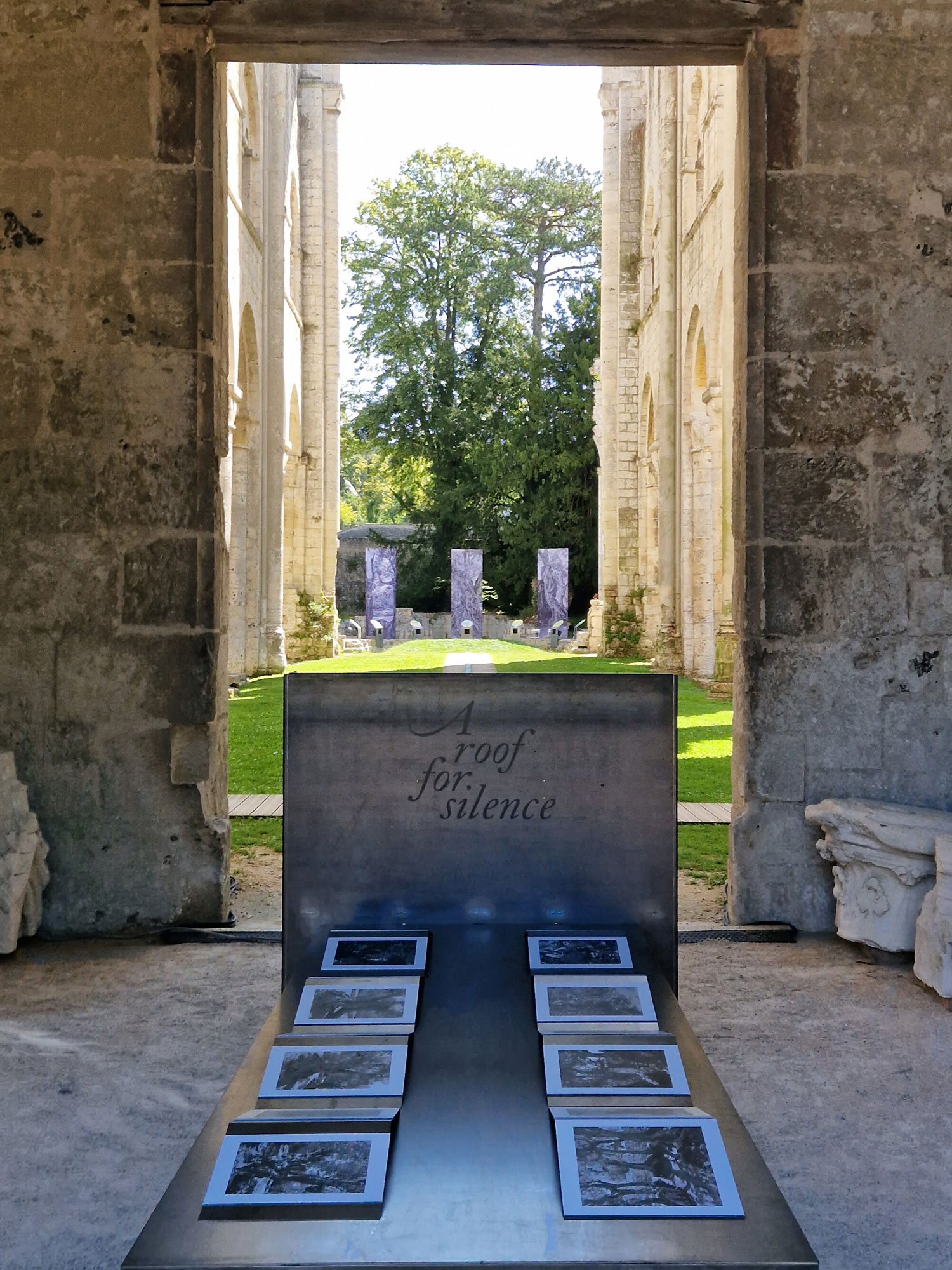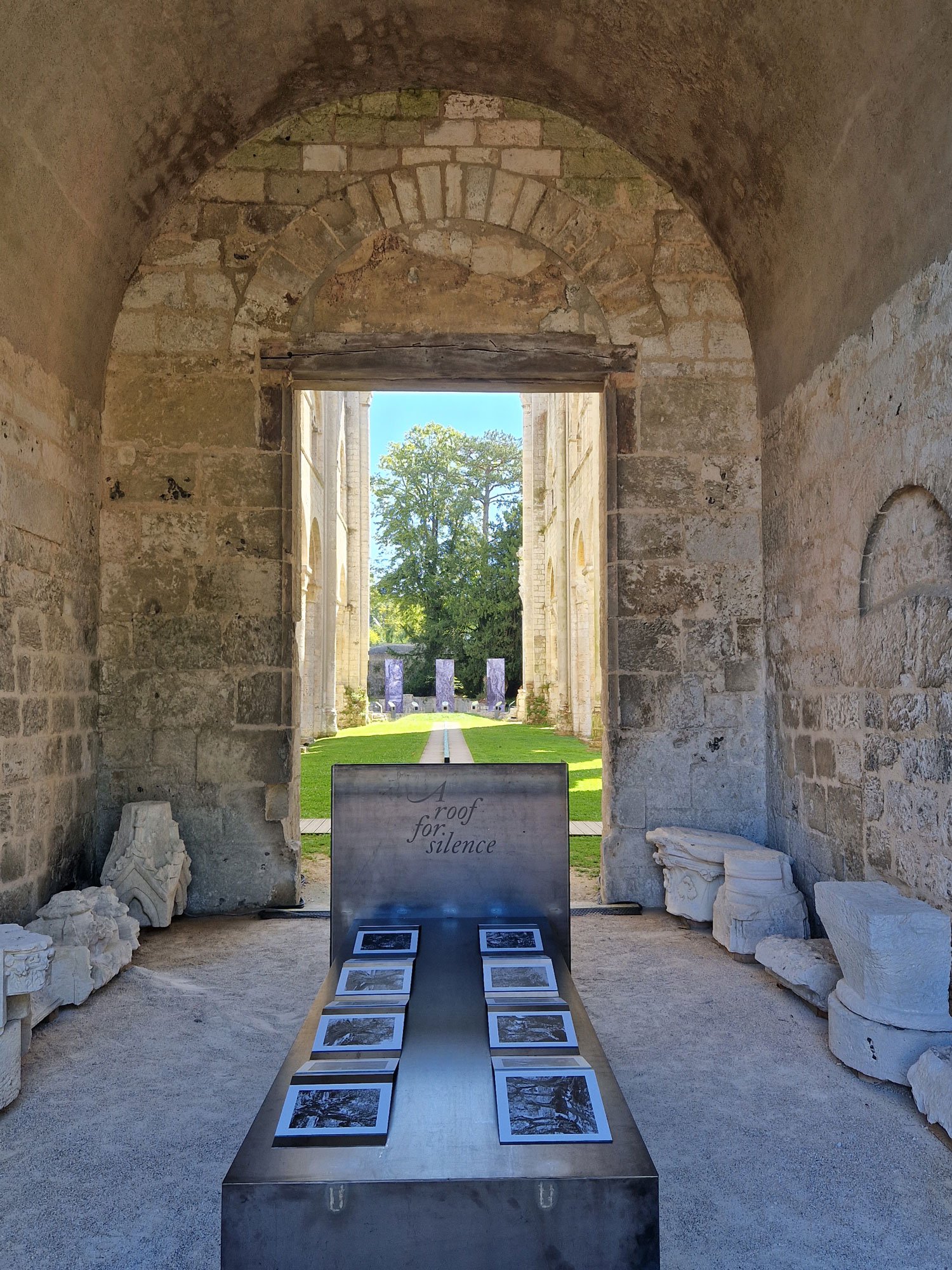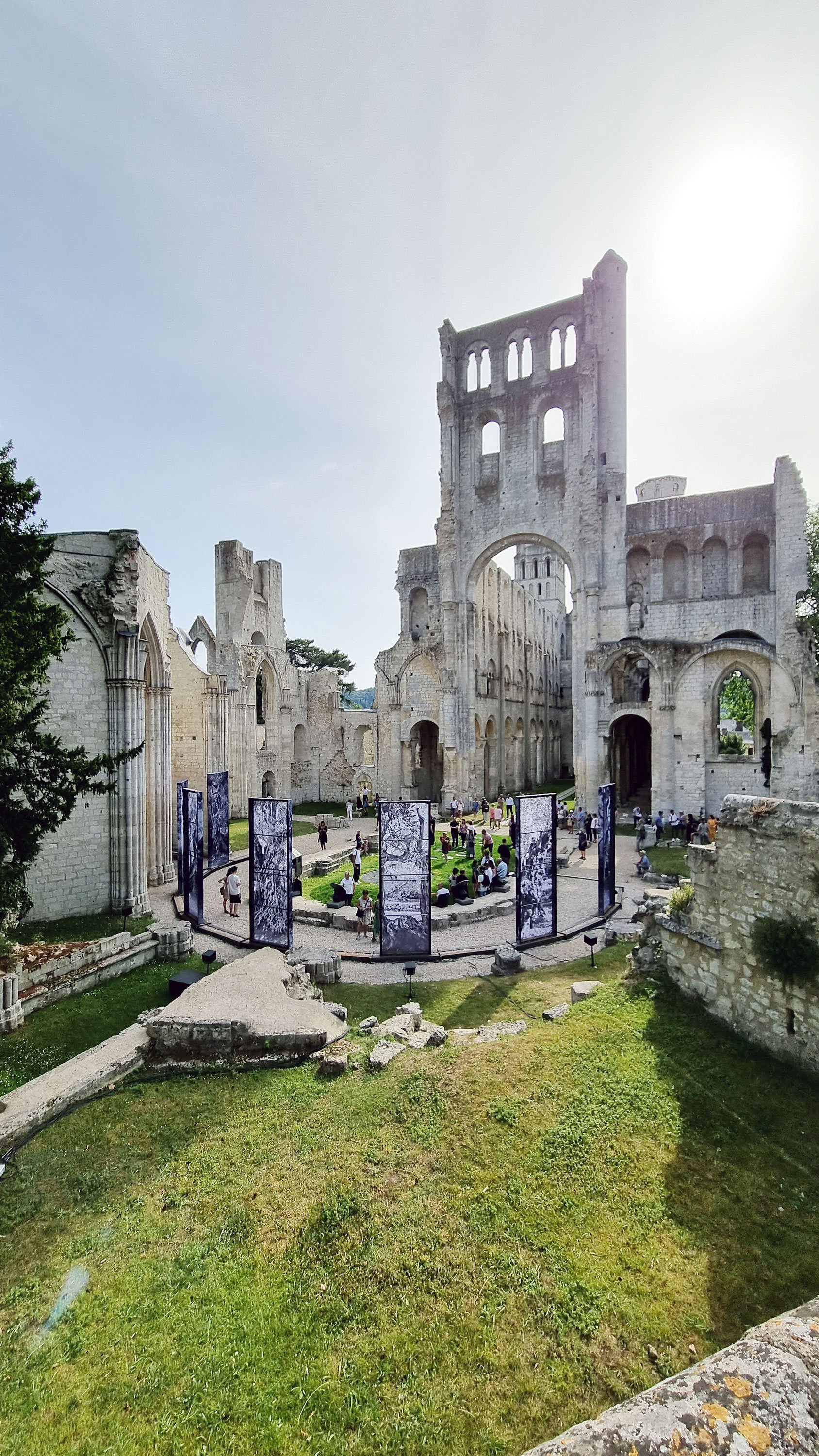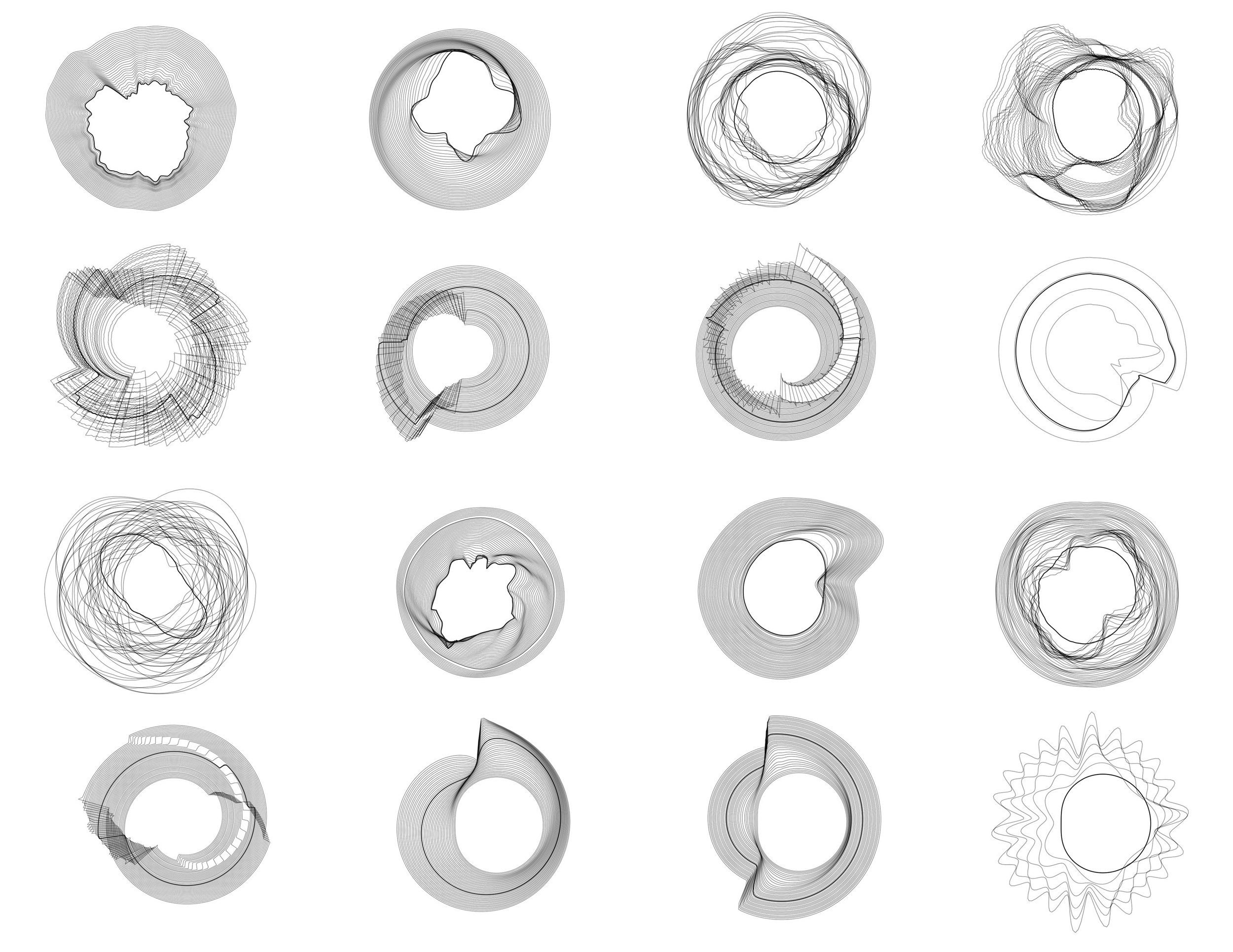NORMANDY | 15 June to 6 November 2022
Abbaye de Jumièges
“There’s so much life around me, and I will have to leave. My breathing is a tide, love doesn’t die.”
— Etel Adnan, Nights
«Il y a tellement de vie autour de moi, et je vais devoir partir. Ma respiration est une marée, l'amour ne meurt pas.»
– Etel Adnan, Nights
A Roof for Silence - Abbaye de Jumièges,
15 June to 6 November 2022
From 15 June until 6 November 2022, A Roof for Silence settles in Normandy, on the majestic site of the Abbaye de Jumièges and its surrounding park; a place rich of a centuries-old history, on the edge of the sacred and profane worlds. The installation, presented in the ruins of the Notre-Dame abbey, is an outdoor variation of the one shown in the Magazzini del Sale in Venice and will echo the one presented at the Palais de Tokyo. It revolves around a reproduction on ceramic of Adnan’s paintings and Fouad Elkoury’s photographs of the olive trees of Lebanon.
A musical setting of the colourful poetry of Etel Adnan
In keeping with the literary and artistic heritage of the abbey, Poetry and Music are at the heart of the installation, which is based on an original sound composition, conceived from the collection of poems by Etel Adnan "Night".
The sound and spatial creation guide the visitor from the entry into the nave to the Choir of the abbey, where fragments of voices and music are perceptible in each of the 7 chapels reconstituted in a semicircle. These fragments are recomposed into a single score at the heart of the Choir.
As part of occasional nocturnal events, Alain Fleischer's film “The Olive trees, pillars of Time” will be screened on the walls of the Abbey, or in the central gallery, depending on the conditions.
A Roof for Silence - Abbaye de Jumièges,
15 juin au 6 novembre 2022
Du 15 juin au 6 novembre 2022, A Roof for Silence s’implante en Normandie, dans le cadre majestueux qu’offrent l’Abbaye de Jumièges et son parc alentours ; un lieu riche d’une histoire pluriséculaire à la lisière des mondes sacré et profane. L’installation, présentée dans les ruines de l’abbatiale Notre-Dame, est une variation en extérieur de celle qui a été montrée dans les Magazzini del Sale de Venise et fera écho à celle présentée au Palais de Tokyo. Elle s’articule autour d’une reproduction en céramique des peintures d’Etel Adnan et des photographies des oliviers du Liban de Fouad Elkoury.
Une mise en musique de la poésie colorée d’Etel Adnan
Dans le respect de l’héritage littéraire et artistique de l’abbaye, la Poésie et la Musique sont mises au cœur de l’installation qui repose sur une composition sonore originale, conçue à partir du recueil de poèmes d’Etel Adnan « Night ».
Véritable colonne vertébrale du projet, cette création sonore et spatiale accompagne le visiteur dès son entrée dans la nef jusqu’au Chœur de l’abbaye, où des fragments de voix et de musique sont perceptibles dans chacune des 7 chapelles reconstituées en demi-cercle. Ces fragments sont recomposés en une seule et même partition au cœur du Chœur.
Dans le cadre d’évènements nocturnes ponctuels, le film d’Alain Fleischer « Les oliviers, piliers du temps » pourra être projeté sur les murs de l’Abbaye, ou dans la tribune centrale, selon les conditions.
Music and poetry
In homage to the abbey’s literary and cultural heritage, we wanted in Jumièges to offer a variation on the work A Roof for Silence that put Poetry and Music back at the heart of the exhibition.
This hinges on an original music composition by Soundwalk Collective, based on Etel Adnan’s poem Conversation with my soul, Night, sung by the artist Mika.
The real backbone of the project, this original creation serves as sound and spatial structure for visitors, taking them on their visit in linear fashion from the moment they enter the nave right up to the abbey choir, and then concentrically, moving outwards from the heart realized on the ground via a recessed mirror roof. Around this centre, fragments of voices and music are audible in each of the 7 chapels pieced together in a semi-circle. These fragments are rearranged into one and the same score at the heart of the Choir.
Supported by its musical structure, the installation comprises 3 sequences tied to the different spaces of the abbey church.
Musique et poésie
Dans le respect de l’héritage littéraire et artistique de l’abbaye, nous avons souhaité à Jumièges proposer une variation de l’œuvre A Roof for Silence qui remette au centre la Poésie et la Musique.
Elle repose sur une composition sonore originale, conçue à partir du recueil de poèmes d’Etel Adnan Night, interprété par l’artiste Mika, en collaboration avec Soundwalk Collective.
Véritable colonne vertébrale du projet, cette création originale sert de structure sonore et spatiale des visiteurs, les accompagnant, d’une manière linéaire dès l’entrée dans la nef jusqu’au Chœur de l’abbaye, puis de manière concentrique à partir du cœur, matérialisé au sol par un miroir/ciel en creux. Autour de ce centre, des fragments de voix et de musique sont perceptibles dans chacune des 7 chapelles reconstituées en demi-cercle. Ces fragments sont recomposés en une seule et même partition au cœur du Chœur.
Portée par sa structure musicale, l’installation se décline en 3 séquences liées aux différents espaces de l’église Abbatiale
Antiforms
An introduction to the issue of emptiness and silence, as observed inside the ancient trees of Lebanon. Sixteen black and white photographic prints by Fouad Elkoury, with large-scale fragments of these standing in the Choir, bear witness to the past and present. Paul Virilio’s Antiforms are presented through a film shown on a screen as an introduction to the physical experience that visitors are able to discover through the pieces of the sky and the landscape cut out by the ruins. The Antiforms sit facing the photogrammetric records of the ancient trees, and are taken up again further along by the impressions left by blown glass on the ground.
Antiformes
Une introduction sur la question du vide et du silence, observés au cœur des arbres millénaires du Liban. Seize tirages photographiques en noir et blanc de Fouad Elkoury, dont des fragments à grande échelle se dressent dans le Chœur, portent le témoignage du passé et du présent. Les peintures Antiformes de Paul Virilio sont présentées par un film dans un écran, une introduction à l’expérience physique que les visiteurs peuvent découvrir à travers les fragments de ciel ou de paysages découpés par les ruines. Elles sont mises en regard avec des relevés photogrammétriques des arbres millénaires, repris plus loin par des empreintes de verres soufflés au sol.
Metamorphoses
Walking through the Nave is an acoustic and musical experience, immersion in the world of the ruins, that takes visitors all the way to the choir and the central work. A trail of glass is laid over the central walk. Shattered by the blast of the explosion in the Port of Beirut, or transformed by a glass blower, these forms embody a form of emptiness that metamorphoses into an Antiform and then an impression scaled to a tree-hollow.
Métamorphoses
La traversée de la Nef est une expérience sonore et musicale, immersion dans l’univers des ruines qui accompagne le visiteur vers le chœur et l’œuvre centrale. Une trainée de verre est disposée sur le chemin central. Cassées par le souffle de l’explosion du Port de Beyrouth, ou transformées par un souffleur de verre, ces formes matérialisent une forme de vide qui se métamorphose en Antiforme puis en empreinte à l’échelle du creux d’un arbre.
Propagation
The central part of the installation located in the abbey’s Choir is presented as a form of spatial fragmentation starting with the original work of the poem-in-painting and its glass case, and reiterating each of its components over three concentric circles that join up with the traces of the Romanesque ruins’ history.
The heart of the choir is marked by a hollow in the ground in the shape of a perfect circle, evoking the inverted dome of the roof, a mirror of the sky and the depth of time.
In an initial circle marking the heart are the artwork of poet and artist Etel Adnan: seven ceramic reproductions of her poem-in-painting, Olivéa: Tribute to the Goddess of the Olive Tree, sit on display stands.
On a second circle, The Olive Trees of Bchaaleh: seven photographic prints by Fouad Elkoury of the olive trees of Lebanon are reproduced on vertical panels and are placed on the traces and ruins of the seven chapels radiating out from the Roman choir.
On a third and final circle, seven loudspeakers broadcast voice fragments that one could to hear individually, and that complete the main choir score.
Propagation
La partie centrale de l’installation située dans le Chœur de l’abbatiale est présentée dans une forme de fragmentation spatiale à partir de l’œuvre originale du poème-en-peinture et de son écrin de verre, reprenant chacun de ses composants sur trois cercles concentriques qui rejoignent les traces historiques des ruines romanes.
Le cœur du Chœur, est marqué par un creux dans le sol en forme de cercle parfait évoquant la coupole inversée du toit, miroir du ciel et de la profondeur du temps.
Dans un premier cercle marquant ce cœur, l’œuvre de la poète et artiste Etel Adnan : sept céramiques reproduites à partir de son poème-en-peinture Olivéa : Hommage à la déesse de l’Olivier, sont posées sur des socles-présentoirs.
Entourant ce cœur, dans un deuxième cercle, Les Oliviers de Bchaaleh, 7 tirages photographiques de Fouad Elkoury des oliviers millénaires du Liban, sont reproduits en panneaux verticaux positionnés sur les traces et les ruines des sept chapelles rayonnantes du chœur roman.
Au fond des chapelles rayonnantes, 7 haut-parleurs forment un troisième et dernier cercle diffusant des fragments de voix que l’on pourra entendre individuellement, complètent la partition du chœur.
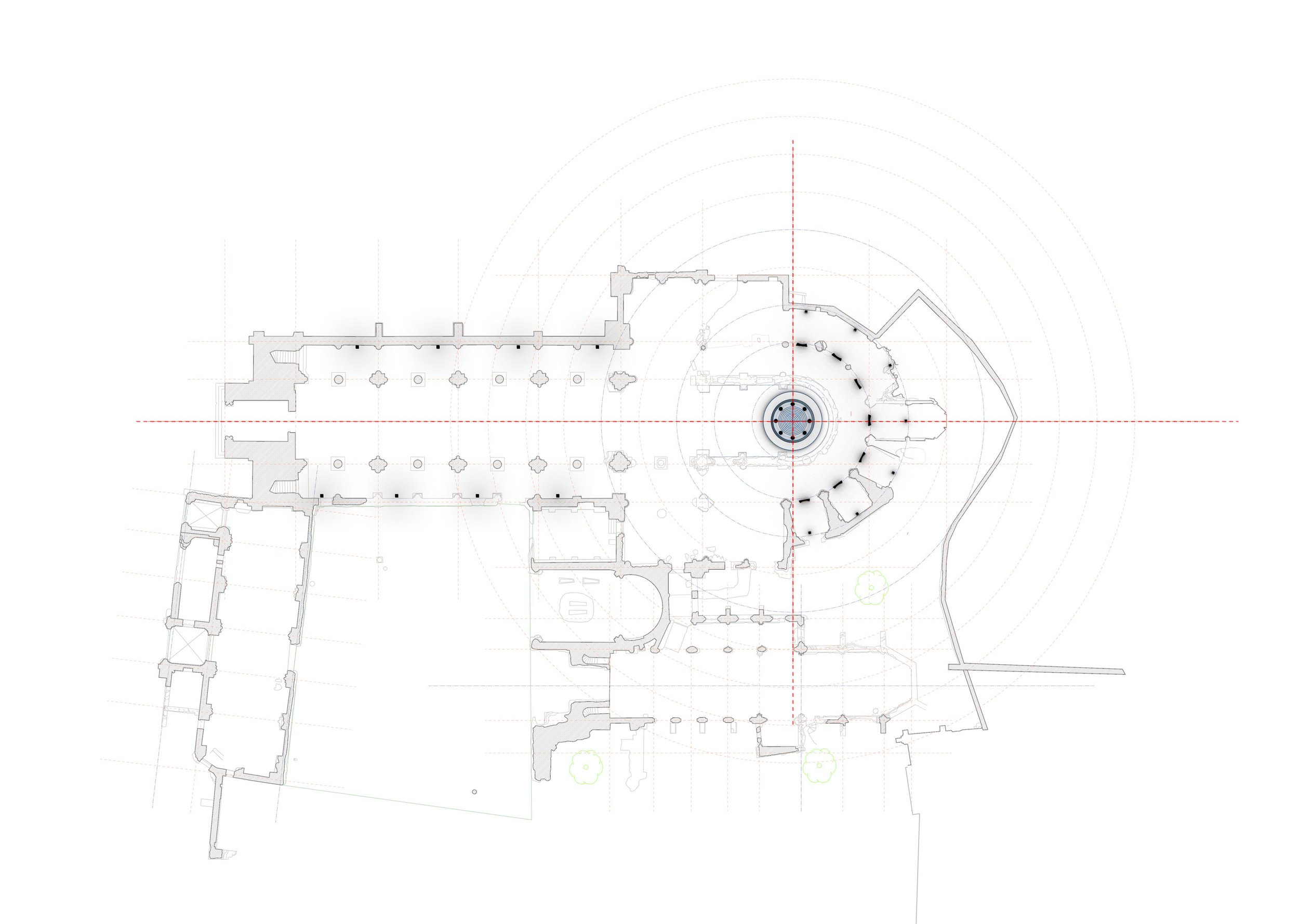
A Roof for Silence | Abbayes de Jumièges | Plan

A Roof for Silence | Abbayes de Jumièges | Perspective
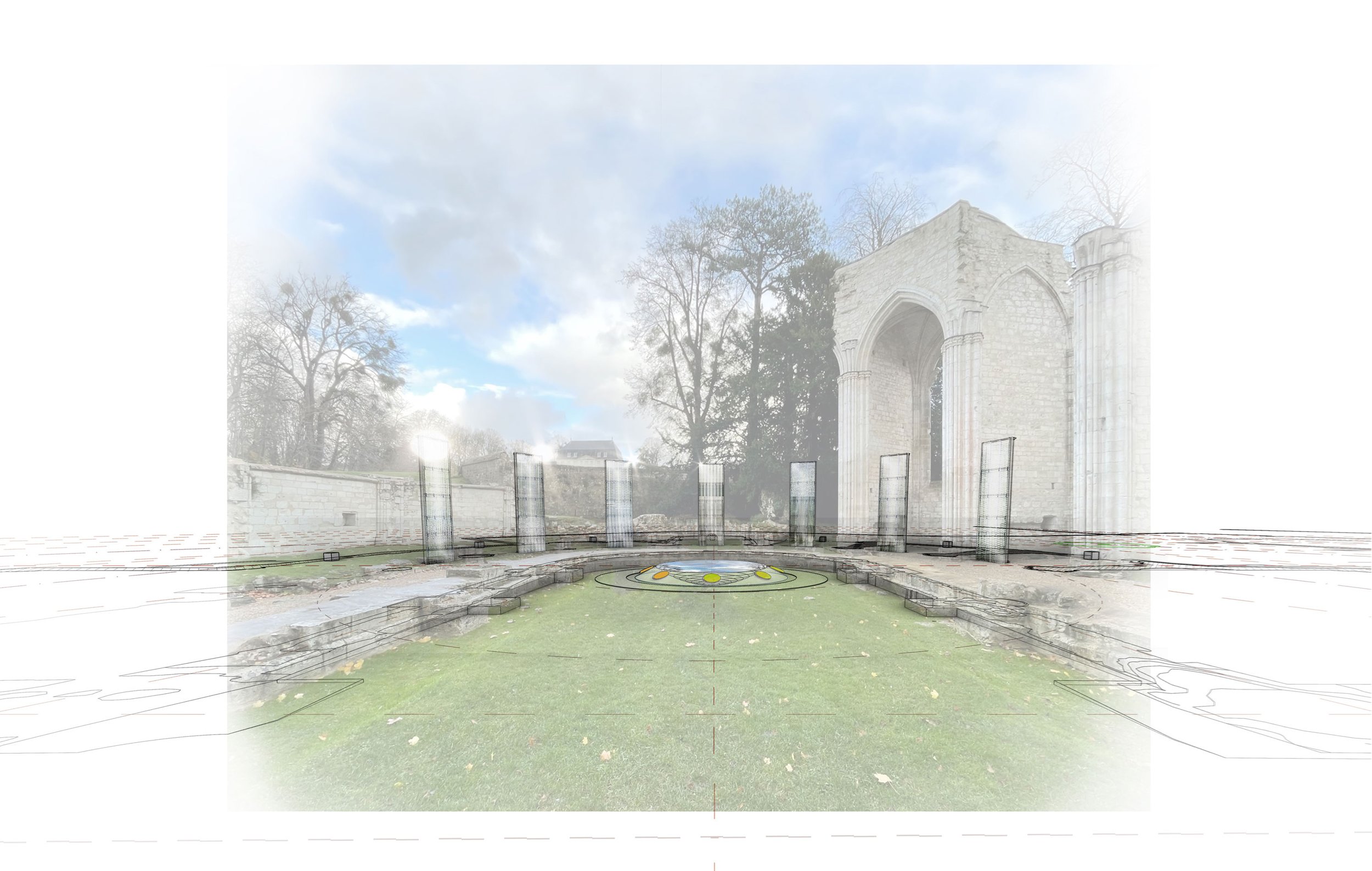
A Roof for Silence | Abbayes de Jumièges | Perspective
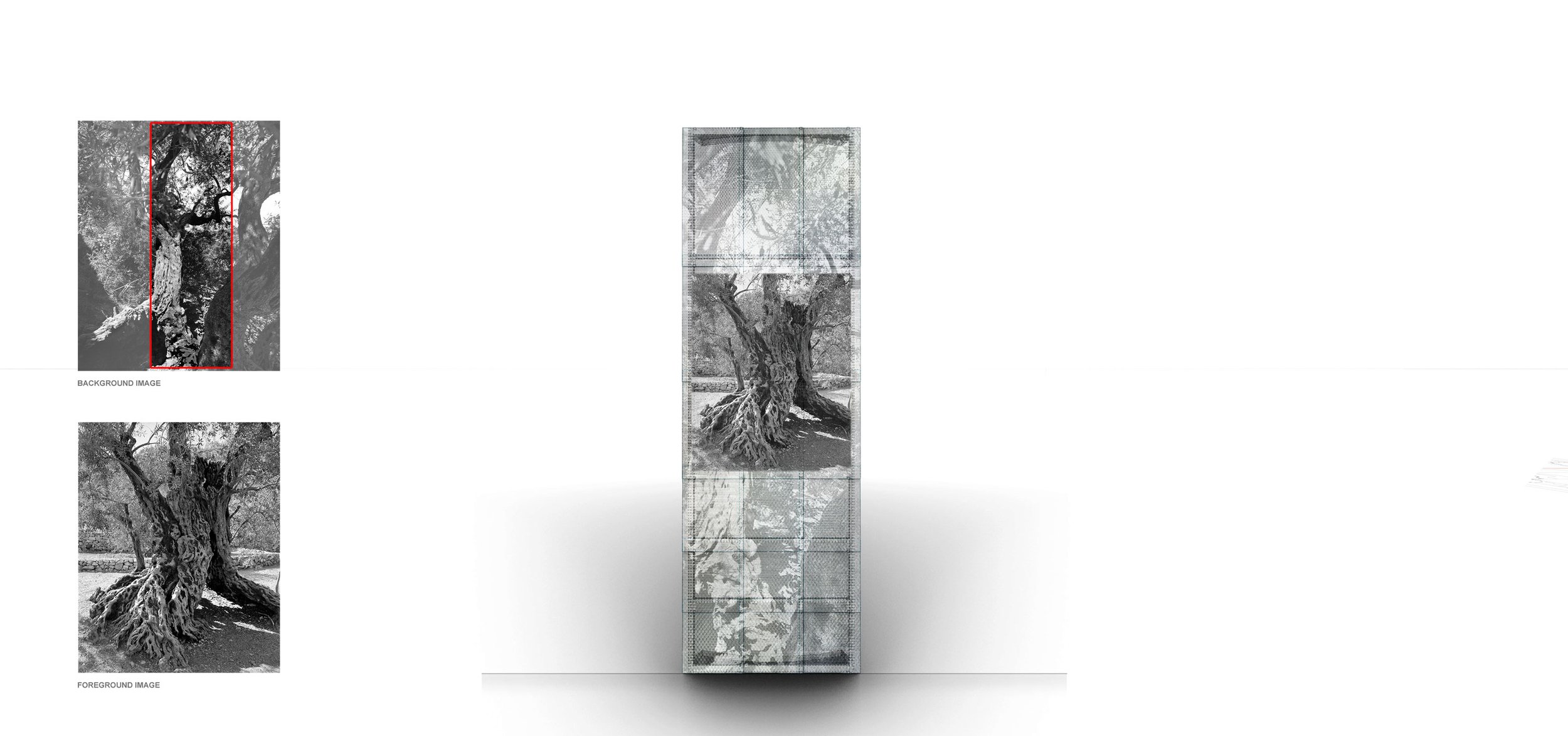
A Roof for Silence | Abbayes de Jumièges | Detail

